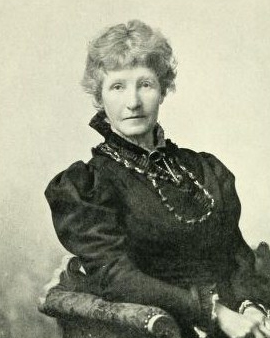Helen Allingham was a British artist best known for her genre paintings. She created watercolors and illustrated children's books. Her parents supported her artistic talent from an early age. Helen Allingham attended the Female School of Arts in London. A year later, she was among the first women allowed to study at the prestigious Royal Academy School. At that time, it was still unusual for women to attend an academy. She also became the first female member of the Royal Watercolour Society.
Genre painting was devoted to depicting mostly rural scenes and village idylls. The style of painting had a centuries-old tradition. Painted were people and actions that had a real relation to everyday life. The subjects were mainly inhabitants of the countryside, their daily work and their homely environment. The figures did not bear individual features, as in portraits. They were rather a characteristic image of their rural surroundings. The books of hours of the 15th century and peasant scenes and family pictures of Dutch painting in the 16th century are considered the models of genre painting. Their negative portrayal of behaviors such as drunkenness and quarrels disappeared from genre painting in the 19th century. From then on, genre paintings showed a romantic and idealized view of country life.
To earn money, Helen Allingham created numerous illustrations for magazines and children's books. For example, she was the only woman to work as an illustrator for the weekly magazine The Graphic. Her growing fame brought her into contact with other well-known artists in London. She eventually married the Irish publisher and poet William Allingham. His circle of friends included the writers Thomas Carlyle and Alfred Lord Tennyson. After marriage, the painter left the weekly magazine and devoted herself to watercolor painting. In 1874, two watercolors of hers were exhibited at the Royal Academy Summer Exhibition. Helen Allington continued to create works after the birth of her three children. Over the years, more than a hundred watercolors were exhibited. Helen Allingham painted old houses and yards that disappeared over time to make way for the advancing industrialization. The extension of the lines for the steam locomotive and the influx of workers and their families changed the landscape. Houses were built to meet the demands of the new era. Due to the artist's attention to detail, it is possible today to get an idea of the original appearance of old cottages from her time. The paintings of the painter often serve as models for the restoration of the remaining old houses. Helen Allingham worked on her paintings until her death. She died after a sudden illness at the age of 78.
×





.jpg)
.jpg)
_-_(MeisterDrucke-1112510).jpg)
_-_(MeisterDrucke-1112510).jpg)
.jpg)
.jpg)
_-_(MeisterDrucke-599150).jpg)
_-_(MeisterDrucke-599150).jpg)
.jpg)
.jpg)
.jpg)
.jpg)
_-_(MeisterDrucke-231511).jpg)
_-_(MeisterDrucke-231511).jpg)
.jpg)
.jpg)
_-_(MeisterDrucke-599235).jpg)
_-_(MeisterDrucke-599235).jpg)
.jpg)
.jpg)
_-_(MeisterDrucke-1106918).jpg)
_-_(MeisterDrucke-1106918).jpg)
.jpg)
.jpg)
.jpg)
.jpg)
.jpg)
.jpg)
.jpg)
.jpg)
 - (MeisterDrucke-637214).jpg)
 - (MeisterDrucke-637214).jpg)
 - (MeisterDrucke-368944).jpg)
 - (MeisterDrucke-368944).jpg)
.jpg)
.jpg)
.jpg)
.jpg)
_-_(MeisterDrucke-372297).jpg)
_-_(MeisterDrucke-372297).jpg)
_-_(MeisterDrucke-1125072).jpg)
_-_(MeisterDrucke-1125072).jpg)
.jpg)
.jpg)
_-_(MeisterDrucke-897601).jpg)
_-_(MeisterDrucke-897601).jpg)
 - (MeisterDrucke-166324).jpg)
 - (MeisterDrucke-166324).jpg)
 - (MeisterDrucke-257944).jpg)
 - (MeisterDrucke-257944).jpg)
_-_(MeisterDrucke-578646).jpg)
_-_(MeisterDrucke-578646).jpg)
.jpg)
.jpg)
_-_(MeisterDrucke-1316027).jpg)
_-_(MeisterDrucke-1316027).jpg)
.jpg)
.jpg)
_-_(MeisterDrucke-1112484).jpg)
_-_(MeisterDrucke-1112484).jpg)
_-_(MeisterDrucke-1488820).jpg)
_-_(MeisterDrucke-1488820).jpg)
.jpg)
.jpg)
.jpg)
.jpg)
.jpg)
.jpg)
_-_(MeisterDrucke-997014).jpg)
_-_(MeisterDrucke-997014).jpg)
 - (MeisterDrucke-39013).jpg)
 - (MeisterDrucke-39013).jpg)
_-_(MeisterDrucke-1130524).jpg)
_-_(MeisterDrucke-1130524).jpg)
.jpg)
.jpg)
.jpg)
.jpg)
.jpg)
.jpg)
 - (MeisterDrucke-168174).jpg)
 - (MeisterDrucke-168174).jpg)
.jpg)
.jpg)
_-_(MeisterDrucke-897817).jpg)
_-_(MeisterDrucke-897817).jpg)
.jpg)
.jpg)
_-_(MeisterDrucke-897604).jpg)
_-_(MeisterDrucke-897604).jpg)
_-_(MeisterDrucke-897597).jpg)
_-_(MeisterDrucke-897597).jpg)
.jpg)
.jpg)
.jpg)
.jpg)
_-_(MeisterDrucke-983110).jpg)
_-_(MeisterDrucke-983110).jpg)
.jpg)
.jpg)
_-_(MeisterDrucke-897782).jpg)
_-_(MeisterDrucke-897782).jpg)
.jpg)
.jpg)
_-_(MeisterDrucke-897708).jpg)
_-_(MeisterDrucke-897708).jpg)
.jpg)
.jpg)
_-_(MeisterDrucke-599232).jpg)
_-_(MeisterDrucke-599232).jpg)
_-_(MeisterDrucke-1122039).jpg)
_-_(MeisterDrucke-1122039).jpg)
.jpg)
.jpg)
.jpg)
.jpg)
.jpg)
.jpg)
.jpg)
.jpg)
.jpg)
.jpg)
.jpg)
.jpg)
.jpg)
.jpg)
.jpg)
.jpg)
.jpg)
.jpg)
.jpg)
.jpg)
_-_(MeisterDrucke-897692).jpg)
_-_(MeisterDrucke-897692).jpg)
.jpg)
.jpg)
_-_(MeisterDrucke-909367).jpg)
_-_(MeisterDrucke-909367).jpg)
_-_(MeisterDrucke-1112506).jpg)
_-_(MeisterDrucke-1112506).jpg)
_-_(MeisterDrucke-921151).jpg)
_-_(MeisterDrucke-921151).jpg)
.jpg)
.jpg)
_-_(MeisterDrucke-897857).jpg)
_-_(MeisterDrucke-897857).jpg)
_-_(MeisterDrucke-897783).jpg)
_-_(MeisterDrucke-897783).jpg)
.jpg)
.jpg)
.jpg)
.jpg)
.jpg)
.jpg)
_-_(MeisterDrucke-897737).jpg)
_-_(MeisterDrucke-897737).jpg)
 - (MeisterDrucke-637228).jpg)
 - (MeisterDrucke-637228).jpg)
.jpg)
.jpg)
.jpg)
.jpg)
_-_(MeisterDrucke-897815).jpg)
_-_(MeisterDrucke-897815).jpg)
_-_(MeisterDrucke-1132406).jpg)
_-_(MeisterDrucke-1132406).jpg)
.jpg)
.jpg)
_-_(MeisterDrucke-1173147).jpg)
_-_(MeisterDrucke-1173147).jpg)
.jpg)
.jpg)
.jpg)
.jpg)
.jpg)
.jpg)
_-_(MeisterDrucke-1099286).jpg)
_-_(MeisterDrucke-1099286).jpg)
.jpg)
.jpg)
.jpg)
.jpg)
.jpg)
.jpg)
_-_(MeisterDrucke-1488545).jpg)
_-_(MeisterDrucke-1488545).jpg)
_-_(MeisterDrucke-1019930).jpg)
_-_(MeisterDrucke-1019930).jpg)
.jpg)
.jpg)
_-_(MeisterDrucke-561185).jpg)
_-_(MeisterDrucke-561185).jpg)
.jpg)
.jpg)
.jpg)
.jpg)
 - (MeisterDrucke-293730).jpg)
 - (MeisterDrucke-293730).jpg)
.jpg)
.jpg)






